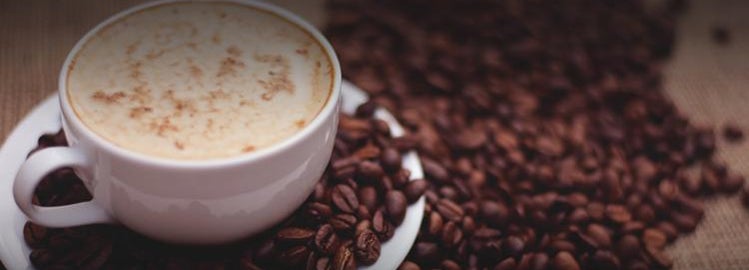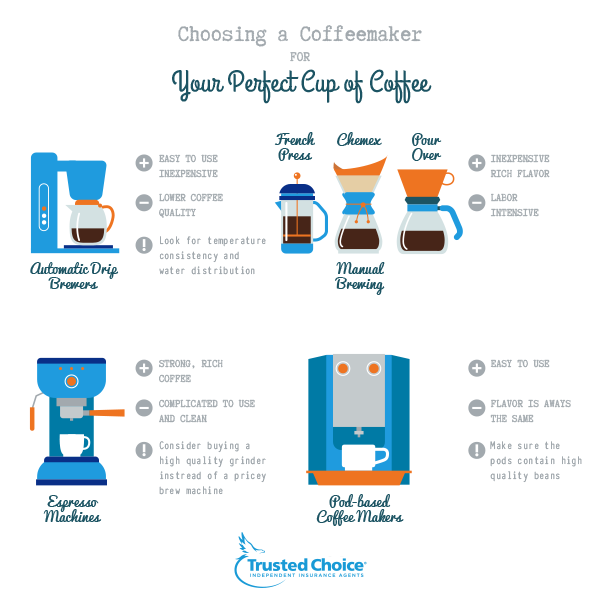Buying a Coffee Maker for That Perfect Cup of Coffee

The best part of waking up ... is having any coffee in your cup. Sure, this may be a variation of the iconic Folgers tagline, but these days, we have access to all sorts of delicious, robust coffee. Whether you get your beans at your grocery store or at a favorite local coffee shop that roasts its own, your choices are fairly endless.
You can get beans from small-batch roasters, flavored beans from Dunkin' Donuts or your favorite roast from Starbucks. That said, whatever you choose to brew also depends on how you choose to brew. With the rise of the coffee shop culture, people have become more discerning about how they brew their coffee. Sure, call them coffee snobs, but people like their coffee made a particular way. You can get an automatic drip brewer, an espresso machine, a pour-over system like a Chemex (an hourglass-shaped unit with proprietary paper filters), a French press, a single-serve pod machine like Nespresso or Keurig and more. Whatever you choose really comes down to your lifestyle.
"The at-home consumer needs to prioritize what their morning or day structure looks like," said Eden-Marie Abramowicz, the retail buyer for Intelligentsia Coffee & Tea roasting company. "If you're always rushed, they should go automatic. If they have time, a pour over is good, but it also depends on how many people you are serving."
And whatever method you use, there are also some core basic rules to follow, according to Brad Kleparek, senior buyer on the electronics team at Williams-Sonoma:
- Start with the best-quality beans possible
- Get beans that have been roasted recently
- Grind beans just before preparing your coffee
- Use a high-quality water source since coffee is 98 percent water
Buying a coffee maker isn't an easy decision. There are so many types in a range of prices. You can spend $20 on a very basic Mr. Coffee machine or upward of $5,000 on a super high-quality espresso machine imported from Italy. So let's break down the various options for buying a coffee maker.
Automatic Drip Brewers
Automatic drip makers are the most common types of coffee machines found in homes. Ranging from fairly basic to more high end, automatic drip coffee makers are the easiest to use. All you need to do, generally, is add coffee grounds in a filter, pour water into the machine's chamber and hit start. Next thing you know, the machine starts producing liquid gold.
"Drip is the most classic method. You have basic coffee makers around $100 and below that have bells and whistles with different strength settings, carafe heaters, auto on/off, grind and brew, etc. Those typically offer a lot on the surface, but the quality of coffee is not that outstanding." –Brad Kleparek, Williams-Sonoma
"Brewed coffee is more manageable and easier to do well at home. Look for temperature consistency and water distribution. When you have the basket with grounds, you want to know the water is hitting every ground and being distributed evenly. The standard $20 Mr. Coffee machine likely will shoot straight down and not hit any grounds on the sides. You'll get over- and under-extracted – and wasted – coffee." –Eden-Marie Abramowicz, Intelligentsia
Espresso Machines
Requiring more time and attention, espresso machines tend to produce a richer type of coffee topped with a bit of crema when pulled properly. Espresso machines can be fairly basic, but when you want a great pull of espresso, you typically will need to spend a bit more money to ensure you get the required amount of pressure to pull your shot.
"Espresso machines need a little more love and care. It's more of an undertaking and takes time. Espresso also requires very consistent temperature stability and nine bars of pressure to pull espresso. You need a bit of machinery to do that so consider counter space and what you want to invest. The more it costs, the more you're paying for good quality. If you're going to steam milk, you'll need a separate boiler in the machine to create pressure. There's a big price jump between a single and double boiler machine." –Eden-Marie Abramowicz
"The method of extraction is different [between espresso and drip coffee]. With espresso, you're exposing the beans to bars of pressure and you're signing up for a little more work. It takes time. Even the best baristas have to spend time getting to know their machines. You have to ask what kind of beverages you're going to consumer. I advocate for coffee enthusiasts to have one of each because they're different." –Brad Kleparek

Manual Brewing: Pour Over, Chemex, French Press
While it's been around for decades, manually brewing has become more popular with the masses in the last five to 10 years. This usually produces a single serve and can be a very rich, robust cup of coffee. There are different kinds of manual brewing:
- The pour over: You literally pour hot water over coffee in a filtered cup that brews coffee directly into your mug.
- French press: You put coffee grounds at the bottom of an enclosed chamber, fill it with hot water and press down a plunger and let is steep. This can produce a very rich coffee that usually yields at least two cups. Be careful because you can easily get grounds in your mouth.
- Chemex: This is a type of pour over, enclosed in a single glass unit often shaped like an hourglass. It uses a thicker paper, which filters out more oil and sediment.
"The biggest division between manual brewing methods is filtered vs. non-filtered, like a French press or anything with a metal filter. Filtered goes through cloth or paper. I do a Chemex every morning. It has a 30 to 40 percent thicker paper, which means it'll remove more oil and sediment to give a clean cup of coffee. The extreme opposite is a French press; that's opaque with coffee grounds. It all comes down to personal preference." –Eden-Marie Abramowicz
Pod-based Coffee Makers
Pod-based machines use small single-use pods filled with grounds. Popular brands like Keurig and Nespresso have caught on in recent years for their ease of use. You just pop the pod into the unit and press start. Pods come in numerous flavors and strengths of coffee.
"I have a difficult time with [Nepresso and Keurig] because they're so consistent. They fool-proofed the system. It produces the same thing everytime [sic] and that takes away all the fun from my point of view. I like to play around with coffee. Making coffee is part of the ceremony and experience." –Eden-Marie Abramowicz
"People love the convenience of Keurig. Nespresso makes a really good single-serve cup and their Vertuoline offers two difference-sized capsules. And you can add steam or foamed milk. I have one on my desk when I don't have more time." –Brad Kleparek
Cleaning & Maintenance
"All coffee machines require some level of maintenance. It's good to know that going in. Even a $100 drip brewer can last longer if you take care of it. Don't let oils and residue build up. Even a French press needs a simple cleaning solution to keep the metals clean. It's like a car: Keep it in good working and you'll get a lot more out of the machine and a better-tasting experience." –Brad Kleparek
Accessories
"You can use a blade grinder, which is more like a food processor that pulverizes your beans. The trouble is that the inside is slick and can be difficult to clean. All that slick oil is flavor you've left inside the bowl. A good burr grinder is the way to go. You can adjust the fineness that will cut the bean to the right shape and size." –Brad Kleparek
"The average coffee maker has a hot plate to keep it warm so a burner holding a coffee is continuing the extraction process. I think a worthy investment, which changed my life, is a thermal insulated container to maintain hot coffee without adding heat." –Eden-Marie Abramowicz
So now that you know what you have available to you. What sort of machine do you think you're likely to get? If you're like some coffee aficionados, you may end up with a few different types of systems. You never know what mood you'll be in when you want to brew a nice cup of joe.
